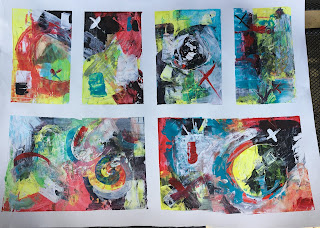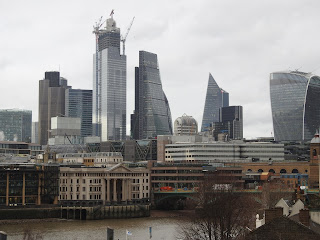I was late joining the course so I have been playing catch up but I thought I'd blog a bit about it here to remind me of what I did. The first assignment involved sectioning off a paper and making marks. Funnily enough I'd worked in this way 10 days before having seen something else online.
I worked randomly using acrylics, acrylic wax, charcoal, artgraf block, oil pastel, Posca pens and water. For the assignment I did something similar:
We had a time limit and I included a few pieces of collage paper this time. Some of them may get some more work on top and one or two work better turned on their side. I find it really difficult to work on top of something I've already done in case I 'spoil' it so I hope that what I am learning from Louise and her inspirational words will help me past this reluctance.
Today I worked really hard without realising how the time was passing so that's already a plus.
I chose colours I wouldn't usually use and a selection of utensils to get the paint onto the paper.
I'd previously cleaned off my palette onto the paper hence the big black area.
The painting went through a few incarnations and while I was painting I was thinking about the sea and rock pools, no surprises there. By the time I got to this point I should have painted it again in my more usual colours and I was tempted to work on top just for the heck of it but my usual fear stopped me doing it.
Instead I started on a fresh piece of paper but jumped to a later assignment to paint completely out of my comfort zone.
I wet the page randomly first and then daubed on black which I wouldn't usually use (there was some red picked up by 'mistake' too.
While the first layer was still damp I slopped on colours taken at random from my palette using a roller again.
More scraping on top,
and oil pastels were employed. I scraped some parts through while the paint was wet with the wrong end of a paintbrush. It was interesting seeing the effects of dragging the pastel through wet paint.
This is the final painting, if you can call it a painting. Throughout I kept seeing areas that I really liked so I've photographed them before painting on top. I just need to remember how I achieved them. I had resisted doing this exercise but I did learn from it, not least that taking a chance and jumping in sometimes have a pleasing outcome. I admire people who are brave enough to paint over whole areas of their painting to the point of obliteration and then sponge back or scrape back to reveal what lies beneath. If you click on the photo above you should be able to see that I accidentally scored through the paper with my scraping and scratching. I'm definitely going to work with this exercise again and learn more about covering up and getting back to a lower layer.
The paper palettes were my all time favourites 😄😄 They'll probably end up as collage papers. I have to thank Louise for pushing me outside my comfort zone and showing me some new ways of working that I am definitely going to keep on with. I've definitely found my joy and excitement for future painting along with the classes I'm doing with Sarah Watson locally.
There's still 2 assignments to do so I'll come back in a few days with some photos. In case you're wondering, I'm still enjoying my weaving but am loving getting back to painting again. Hopefully between the two I will still be able to be creative despite the arthritis in my hands. I wouldn't like the alternative, but senior years do have their grumpy and frustrating moments.




























































